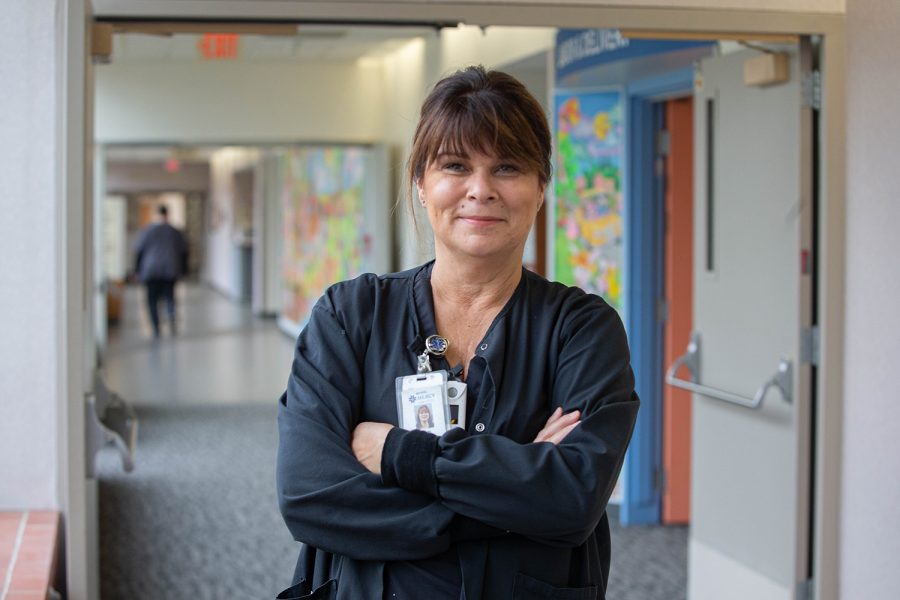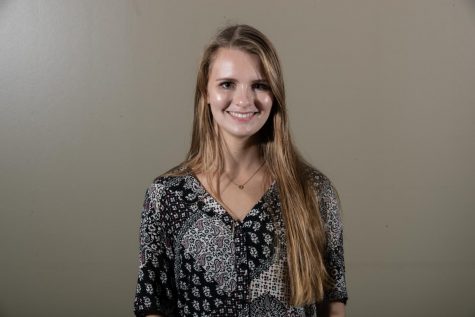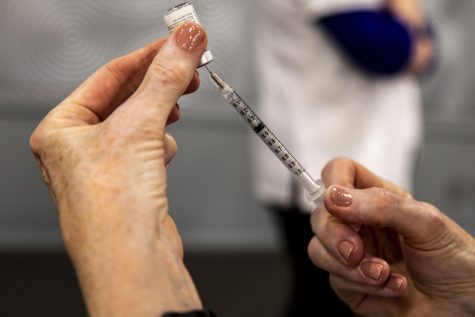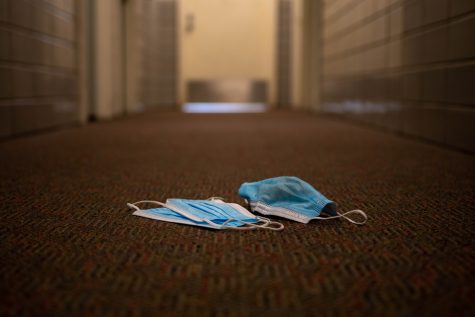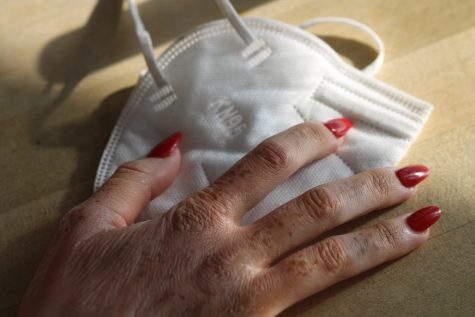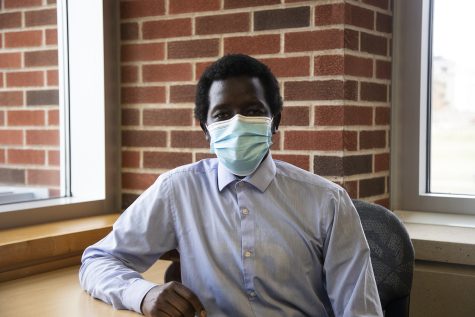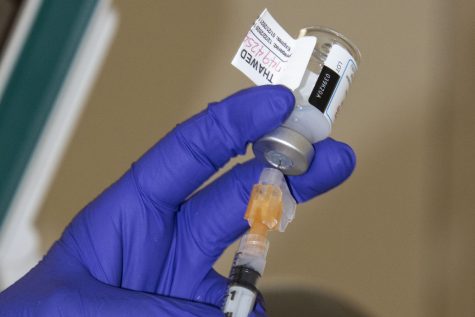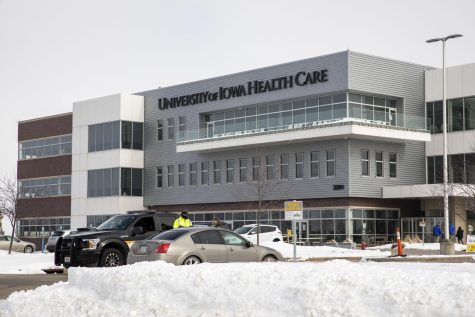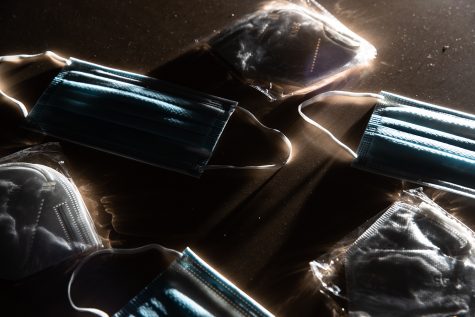First responders, frontline workers find life has shifted a month since COVID-19 cases first reported in Iowa
First responders grapple with the changes, both professionally and personally, that have occurred as a result of COVID-19.
Nurse manager and paramedic Kim Lopez poses for a photo in Mercy on Wednesday, April 15, 2020.
April 16, 2020
Health-care worker Kim Lopez brings chocolate-chip bars and spaghetti to work for her staff — the latest commodities in a snack delivery she tries to do weekly.
Lopez, nurse manager of the Mercy Hospital Emergency Care Unit and volunteer paramedic for Durant, said her staff can always tell when she’s stressed if she brings them food. Because COVID-19 social-distancing recommendations don’t allow for her three weekly visits to the gym, Lopez said baking has become one of her primary stress-relievers. Staff often don’t eat lunch because of how busy it is in the ER, she said, so she tries to cook for them or bring in snacks to munch on.
At the outbreak of COVID-19, finding something to eat became even more of a challenge for hospital staff. But now the community has stepped up, and restaurants, businesses, and community members are donating food in a show of support for health-care workers.
Miles away, Sgt. Kevin Bailey, Iowa City police patrol supervisor, continues to patrol the streets, wistfully waving from the windows at kids in the park or birthday parties. Whereas he could say hello before the spread of the novel coronavirus, now he keeps his distance.
“It’s just odd to have that forcefield around us from the public,” Bailey said. “But we’re doing that to keep us healthy, but also to keep the public healthy.”
Johnson County Ambulance Services Director Fiona Johnson said her days have lengthened from eight hours to 11 hours, and even then, she often doesn’t complete everything she needs to. She keeps a laptop at home so she can finish her work while still being close to her family, Johnson said.
“I really worry about the staff,” Johnson said. “It’s really about making sure they have the [personal protective equipment] they need and that they are managing their stress because, really, mine is minimal in comparison to what they have to deal with out on the ambulance.”
Just over a month since Iowa Gov. Kim Reynolds confirmed community spread of COVID-19, life for first responders and front-line workers has shifted. It takes longer for health-care workers to see and treat patients in the ER because of the time it requires to tug on their personal protective equipment, and officers must speak to victims of violent crimes from six feet away. Both have longer work hours.
Lopez, a 55-year-old mother of two, nurse of more than 20 years, and a paramedic for more than eight years, fears bringing COVID-19 home to her husband, who is 10 years older than her and diabetic.
“I think we see a lot of fear right now in the community and in health-care providers,” Lopez said. “We work hard to educate people and let them know that we are doing our best to protect them and protect ourselves at the same time.”
RELATED: Social workers, child-welfare services fight for child safety and family support during COVID-19
Lopez was in the ER every day for the first 20 days of the coronavirus crisis, trying to organize and ensure her staff had the protective equipment they needed. She was one of many putting in extra hours in the first three weeks, she said.
As a volunteer paramedic for Durant, Lopez said her normal alerts would include stroke or heart attack alerts, but now there is an additional “gold” alert for someone coming in with respiratory issues.
Lopez described answering a call for someone with a “gold alert” on Saturday, as she wore a face shield, mask, gown, and gloves to take care of the patient. Before COVID-19, an entire ambulance crew used to get the patient on the cart and bring them out, but now a limited number of first responders enter the home to retrieve them and the driver must stay in the front.
Lopez described it as working more independently than she is used to.
“It’s a little unnerving to be in the back of an ambulance with someone in a small, confined space for a period of time not knowing what they have,” Lopez said. “We have our protective gear, we put on the outside fan, and we do our job, and we bring them in.”
Johnson nevertheless described her worry about patients waiting too long to seek out help because they fear that they will contract COVID-19 at the hospital.
“It’s a little unnerving to be in the back of an ambulance with someone in a small, confined space for a period of time not knowing what they have.”
— Kim Lopez, Mercy Hospital nurse manager
In the beginning of the crisis, she said people would call 911 out of fear. Concerns that they may have COVID-19 led to emergency calls because people were unsure whether what they were feeling was COVID-19, even if they displayed little to none of the symptoms commonly associated with the respiratory disease caused by the novel coronavirus.
“I think that has shifted now and people are less likely to call 911 to go into the emergency room, because now they are at the opposite end of that spectrum of anxiety,” Johnson said.
She described patients with non-COVID-19 ailments waiting until the last minute to call an ambulance, afraid of becoming infected in the emergency room.
“So, we’re getting people that maybe should have called 911 sooner and didn’t because they didn’t really want to go to the emergency room if they absolutely didn’t have to,” she said. “So, it’s been an interesting shift in the types of calls that we’re receiving.”
Sgt. Derek Frank, Iowa City police public-information officer, said calls to the police have dropped dramatically, despite the department fielding about five calls a day for COVID-19-related concerns.
Most are community members who have questions about mandates from the governor or feel like the police should be enforcing social distancing, Frank said.
Bailey highlighted one instance when a neighbor called about a group of four people playing tennis outside, and two of them were wearing masks.
“Not every call that we’re getting in are people that are actually in violation,” Bailey said. “It’s just, people are worried.”
Frank said the police haven’t written any citations for violating the 10-person gathering limit yet, and their goal is to ensure that everyone is aware of the rules and mandates and following them. The department’s goal is not to go out and catch people in violation, he said. If the only way to address the problem was with a citation, Frank said officers would give them out.
Moving forward, Lopez said the best thing the community can do to help first responders is to stay home and, if they have the capability to make masks or gowns, donating them can help protect providers.
“We’re doing our job. We’re doing our job every day. And [people] act like it’s something special but this is what we do every day… We’re just doing what we’re supposed to do and making the best of the situation, and I think no matter whether you’re working in an ambulance or you work in a hospital, everyone is a little afraid,” Lopez said. “But we’re all doing the best we can and taking the best care of patients that we can.”



